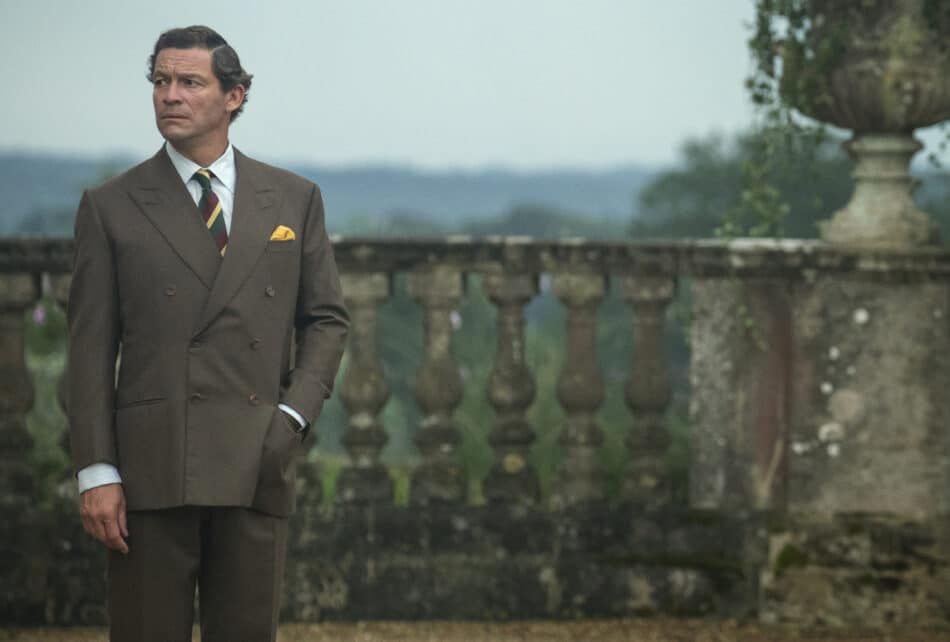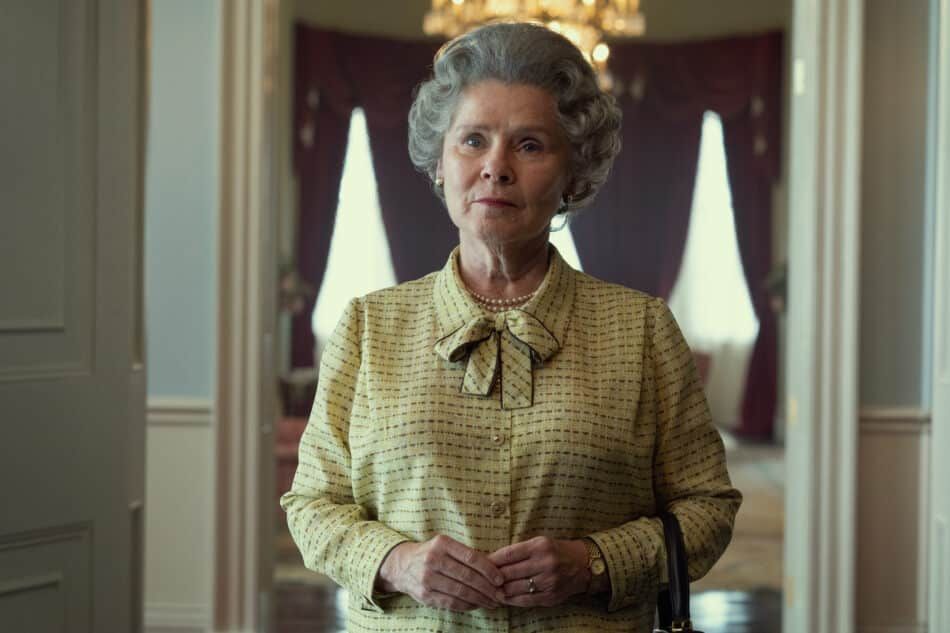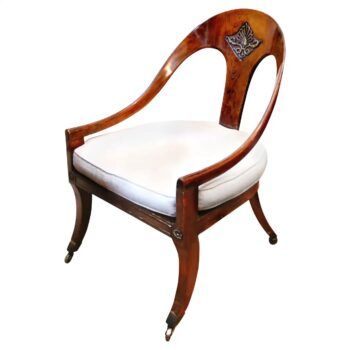
Fans of the Emmy- and Golden Globe–winning Netflix series The Crown were thrilled, when, in 2020, Netflix announced that it had renewed the show for a sixth season instead of ending it after five as originally planned. According to a statement released by series creator Peter Morgan, as the team began to discuss storylines for the last season, “It soon became clear that in order to do justice to the richness and complexity of the story we should go back to the original plan and do six seasons.”
But another season won’t bring us closer to the present day. We can expect the series to end somewhere in the early 2000s, which means we’ll see Kate Middleton come onto the scene — but nothing of Meghan Markle, who entered the royal orbit in 2016, the same year The Crown debuted.
The Crown has won or been nominated for numerous prestigious awards every year since then. In 2021, the series swept all seven drama categories at the Emmy Awards, making history as the first show to do so. The sweep came as no surprise to many — the combination of glorious sets, sumptuous costumes, masterful screenwriting and brilliant acting has made The Crown wildly popular in households across the globe.
The sixth season still lies in the future. But with the fifth (and no longer final) one about to begin, we dive into the people, places and particulars of the show and speculate about what we might see.
Who’s Who in Season 5?

Season 1 of The Crown takes up the royal storyline in 1947 and delves into the illness and death of King George VI and the ascension of Queen Elizabeth II to the throne. As the series progresses through time and the characters age, new actors take over, often to much fanfare.
This time around, Queen Elizabeth is portrayed by Imelda Staunton, Princess Diana is played by Elizabeth Debicki, and Prince Charles is played by Dominic West. Dodi Al-Fayed, Princess Diana’s post-divorce love interest, is introduced in this season, played by Khalid Abdalla.
Lesley Manville portrays Queen Elizabeth’s sister, Princess Margaret, and Claudia Harrison takes over the role of the Queen’s daughter, Princess Anne. Jonathan Pryce rounds out the cast as Prince Philip.
What Is the Release Date for The Crown Season 5?

Season 5 of The Crown lands on Netflix on November 9 to a potentially far wider viewership than previous seasons had. The show experienced a resurgence in popularity following the death of Queen Elizabeth II on September 8, propelling the first season of The Crown into the Netflix top 10 a week later.
Aside from a few hints and the odd spoiler, there’s not much information available on where season 5 will end and season 6 will pick up. What we do know is that these final two seasons of the show will cover the 1990s and early aughts — and they’re expected to be as richly portrayed and opulent as the four seasons that came before.
Of course, this kind of quality doesn’t come easy — or cheap. The Crown is notoriously expensive to produce, given its careful attention to detail.
“The ambition of this project is unlike anything ever made in Britain,” series producer Andrew Eaton said in 2017, noting that the show’s creative team had to push a lot of boundaries to give the sets the scale they needed. “If you’re telling a story about one of the wealthiest, most famous families in the world, you’ve got to live up to that.”
Here, in anticipation of a lush visual ride down memory lane, we dive into the jewelry, fashion and furnishings we’ll be watching out for this season.
The Jewels of The Crown

For fans of royal jewels, The Crown has been a feast for the eyes. Although we’ve already seen some notable pieces in previous seasons, we’re hoping for more. As the show progresses through the 1990s in season 5, watch out for these famous jewels (which sometimes are interpretations instead of exact replicas) that contribute to the backstory.
The Spencer and Lover’s Knot Tiaras

The Spencers, Princess Diana’s family, trace their history back to 1066, the era of the Norman Conquest. Like other aristocratic families, the Spencers possess several tiaras, including what is known as the Spencer tiara. Made in part from family heirlooms, the headpiece was constructed in the 1930s by Crown Jeweler Garrard and features stylized flowers and foliage made of diamonds, all set in silver and gold.
Although traditionally a wife wore the tiaras of her husband’s family after her marriage, Diana broke protocol by continuing to wear the Spencer tiara to formal events throughout her marriage. The reason? Diana often got headaches from wearing these heavy headpieces, and the Spencer tiara was lighter weight and more comfortable than others at her disposal.
As for the Lover’s Knot tiara, the knots of diamonds in the design symbolize unbreakable love. Given to Queen Elizabeth by Queen Mary, the Lover’s Knot tiara hasn’t yet made an appearance on Princess Diana in The Crown, but it looks like she’ll be wearing it in season 5.
Prince of Wales Feather Brooch
In 1863, the Ladies of North Wales presented Princess Alexandra of Denmark with a diamond-studded brooch to commemorate her marriage to the future King Edward VII. In the center of the brooch are three ostrich feathers encircled by a crown, the traditional symbol of the Prince of Wales. The crown bears the motto, Ich Dien, or “I serve,” and the piece is surrounded by 18 round-cut diamonds alternating with small emeralds. A detachable emerald pendant hangs from the bottom of the brooch.
Prince Charles became Prince of Wales in 1958, and following his investiture in 1969, he began to use his feather symbol. When he married Diana, who became the first Princess of Wales in more than 100 years, he gifted her the brooch. Princess Diana preferred necklaces, so she combined the piece with a diamond line necklace and debuted it at the Royal Opera House in 1982.
The royal brooch was given back to the Queen after Charles and Diana’s divorce in 1996 and resurfaced in 2006, worn by then-Prince Charles’ new bride, the then-Duchess of Cornwall, Camilla Parker Bowles.
Sapphire and Diamond Engagement Ring
When Lady Diana became engaged to Prince Charles, she was presented with a tray of rings from Garrard. One captured Lady Diana’s attention — a 12-carat Ceylon sapphire ring encircled by diamonds and set in 18-carat white gold.
Unlike most royal engagement rings, the one Princess Diana chose wasn’t a one-of-a-kind piece commissioned from the Crown Jeweler, but rather a catalog offering for anyone who could swing the $60,000 price tag.
That Diana chose a catalog ring raised some eyebrows within the royal family, and speculation abounded — some said she picked the biggest one, some said Diana liked that it matched her eyes, or that it reminded her of her own mother’s engagement ring.
But Diana wasn’t bothered that anyone off the street could own the same ring — and besides, it was the Prince of Wales, now the King of England, who included it in the choices because of its connection to Queen Victoria. While her reign is associated with a diverse group of jewelry, Victoria adored sapphires. Prince Albert gifted her many, including a sapphire brooch by Garrard that the Queen wore as “something blue” at her wedding. This brooch inspired the ring.
When Princess Diana died, the engagement ring went to Prince Harry, who sweetly offered it to his brother Prince William to give to Kate Middleton upon their engagement, saying it would be fitting because one day the ring would be sat on the throne of England.
Collingwood Pearl Drop Earrings

Collingwood & Co., a London jeweler favored by the Spencer family, presented a pair of pearl and diamond earrings to Diana as a wedding gift, but the princess-to-be didn’t wait for her special day to wear them. These classic, timeless earrings feature pearl drops in a bell cap ringed with three rows of diamonds. The bell cap is suspended from a round diamond, which is suspended from a round diamond stud.
The pearl drop earrings are now in the possession of Kate Middleton, who has worn them often — including during the procession of the Queen’s coffin from Buckingham Palace to Westminster Abbey on September 14.
The Couture of The Crown

Emmy-winning costume designer Amy Roberts has dressed the cast of The Crown since season 3, and she’s back to bring the exact right vibe to season 5. In previous seasons, many of the royals’ looks are inspired by the originals rather than faithful copies, and season 5 is expected to be no different. The costuming crew sourced outfits from vintage shops, thrift stores and flea markets to find clothing with the spirit of the originals.
Princess Diana became a fashion icon early on, and she remained one until the end. Though she was a quiet person, she was warm, and her warmth — and independent-mindedness — was communicated through her clothes. The pleasant, stalwart fashion sense of the royal family was a bit shaken as Diana often and unapologetically wore what she liked.
Her fashion choices became more daring as her relationship with Prince Charles came to an end. In June 1994, on the same day Prince Charles publicly admitted to his infidelity on TV, Princess Diana wore a black, off-the-shoulder, bodycon dress to an event at the Serpentine Gallery in London. Designed by Christina Stambolian, it became known as her “revenge dress.” It wasn’t Diana’s last LBD — or her last time dazzling the press and her fans with her intriguing, evolving post-royal style.
The mid-1990s Diana of The Crown season 5 has the confidence and self-assuredness that last season’s 1980s Diana lacked — or hid behind yards of fabric adorned with ruffles and poufs. Simpler black dresses became her go-tos, and some of her favorites were the tank dresses designed by Versace.
Setting the Stage for The Crown

Filming for The Crown takes place in many locations, including estates throughout the UK and Elstree Studios in London. Production designer Martin Childs — who won an Emmy Award for season 1 of the show — told Architectural Digest in 2016 that Peter Morgan’s scripts give the production design team a lot of freedom in creating the settings. “As a designer, I especially love them for that. They tell the story in movement and dialogue, inviting me and my team to create a world in which that story can believably take place.”
The sets are built from the ground up, starting with weeks of research into the period the season covers. Once it became clear that the real royal family was unwilling to assist the show’s creators, Childs posed as a tourist, using tours of Buckingham Palace as covert reconnaissance missions to inspire his vision for the sets. In addition, he and his team scour vintage photographs, film footage and interior decorating books of the period.
Armed with the script and a vision, the team creates the sets, sourcing fabrics, furniture and accessories from flea markets, antique shops and prop houses. By the end of the third season, the design team had collected a warehouse full of props, which they repurpose for various sets and add to when needed.
“Fortunately for us,” set director Celia Bobak told Set Decor magazine in 2017, “large country houses and palaces do not change over the years. A television or a radio, perhaps, but not much else changes unless a renovation is done.”
Bobak set the bar high for authenticity during her time as set decorator for season 1 of The Crown. Although no real Windsor artifacts are used as props, people often think the sets are more authentic than they are, Childs says, adding, “We must be getting our fakery right!”
Here are a handful of the many royal palaces, estates and rooms we’ll be invited into in season 5.
Balmoral Castle
Standing in for Balmoral Castle, the Queen’s private family home purchased by Prince Albert in 1852 for Queen Victoria, is Ardverikie Castle near Inverness, Scotland. Its 19th-century Gothic style is similar in appearance to the royal estate, a brooding structure with gloomy turrets.
In season 4, episode 2, “The Balmoral Test,” both Princess Diana and Prime Minister Margaret Thatcher are invited to Balmoral for a weekend, during which they’re sized up by the Queen and other members of the royal family. Diana easily passes muster under scrutiny, since she came from a similar background, but Margaret Thatcher fails dismally, suffering humiliating wardrobe miscalculations and other social faux pas.
Over the decades, Balmoral, considered to be the Queen’s favorite home, was the setting for lively royal parties, hunting holidays and scandals for family and dignitaries alike. During Queen Elizabeth II’s reign — which ended with her death at Balmoral on September 8 — the prime minister of the time was invited at least annually to spend a weekend at the castle. Some prime ministers, like David Cameron, loved the visits, while others, like Margaret Thatcher, purportedly loathed them.
The 15th and last British leader to visit the Queen at Balmoral Castle was Liz Truss. On September 6, two days before the monarch’s death, the Queen appointed Truss prime minister. Although this ceremony normally takes place at Buckingham Palace, the Queen’s mobility issues prevented her from making the trip to London.
In season 5, the young princes William and Harry, played by Rufus Kampa and Will Powell, are at Balmoral when they’re told the news of their mother’s death.
Windsor Castle

Word has it that season 5 will give plenty of air time to the year 1992, which Queen Elizabeth famously called her “annun horribilis.” That was the “horrible year” when Windsor Castle caught fire, Charles and Diana split up and a series of other royal breakups and scandals shook the family.
In The Crown, Windsor Castle, which serves as the Queen’s weekend home, is played by two estates: The Burghley House in Lincolnshire and Belvoir Castle in Leicestershire.
Buckingham Palace

The official residence of the British monarch since 1837, the 775-room Buckingham Palace is the backdrop for some of the most memorable scenes in The Crown so far. One stand-in for the royal palace is London’s Lancaster House, a neoclassical mansion built in 1825 on Pall Mall, a three-minute walk from Buckingham Palace.
Kensington Palace

Expect to see a lot of Kensington Palace in season 5. The birthplace and childhood home of Queen Victoria, this Jacobean mansion started out as a small suburban villa, which was purchased by William III in 1689 and redesigned for him and his queen, Mary II, by renowned London architect Christopher Wren.
Several locations used for Kensington Palace include Brocket Hall, a sprawling estate built in 1760 in Hertfordshire.
Princess Diana and Prince Charles lived in apartments 8 and 9 at Kensington until their divorce in 1996, and Diana continued living there until her death in 1997.
Highgrove House

Around the time Prince of Wales and Lady Diana Spencer began dating, Charles purchased this late 18th-century, Georgian neoclassical estate in Gloucestershire. It served as Charles and Diana’s country house, but while Princess Diana had Highgrove House redecorated, she was never a fan of it — likely because Camilla Parker-Bowles lived nearby.
Highgrove House — where King Charles currently resides with now- Queen Consort Camilla — is represented in The Crown by the enchanting Somerley House, on the Hampshire-Dorset border.








